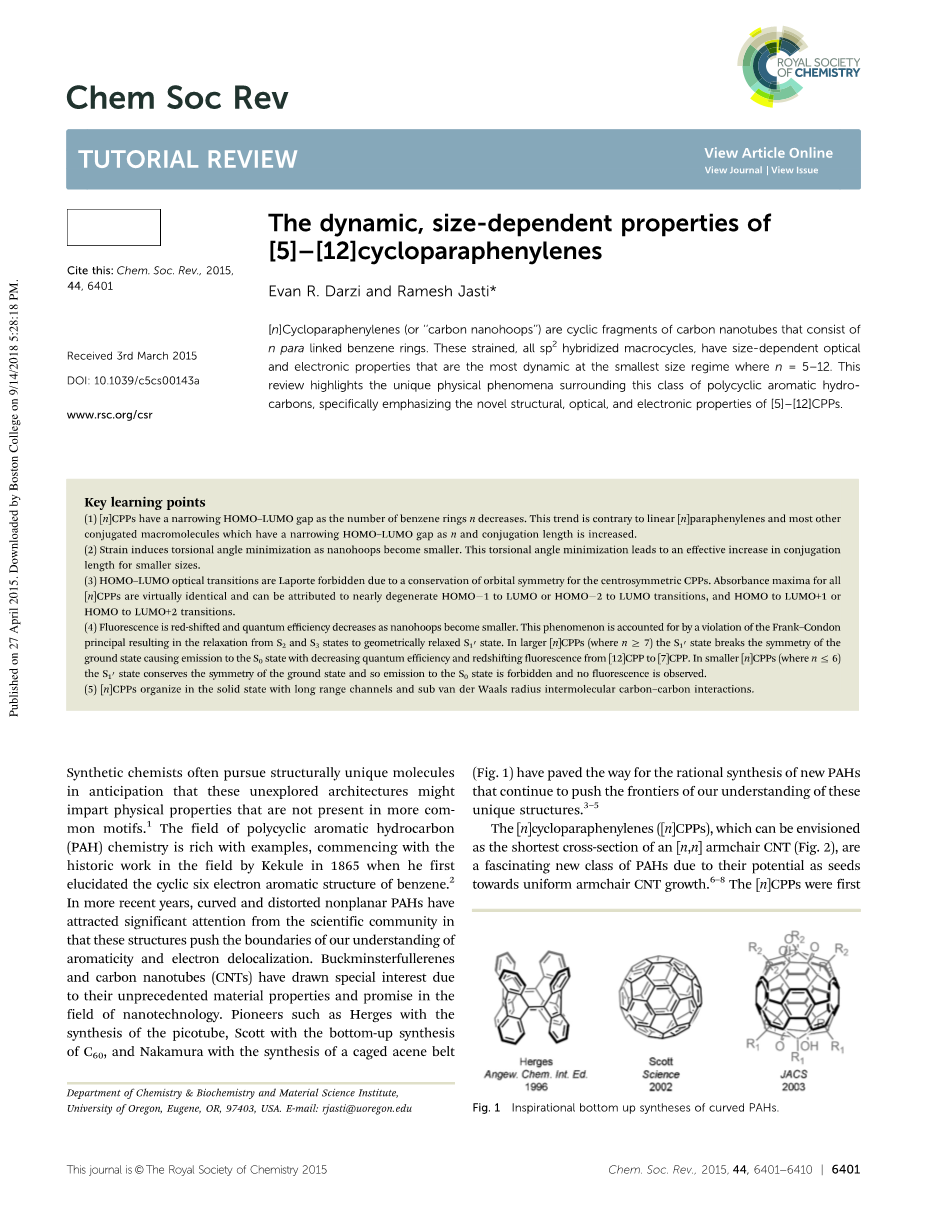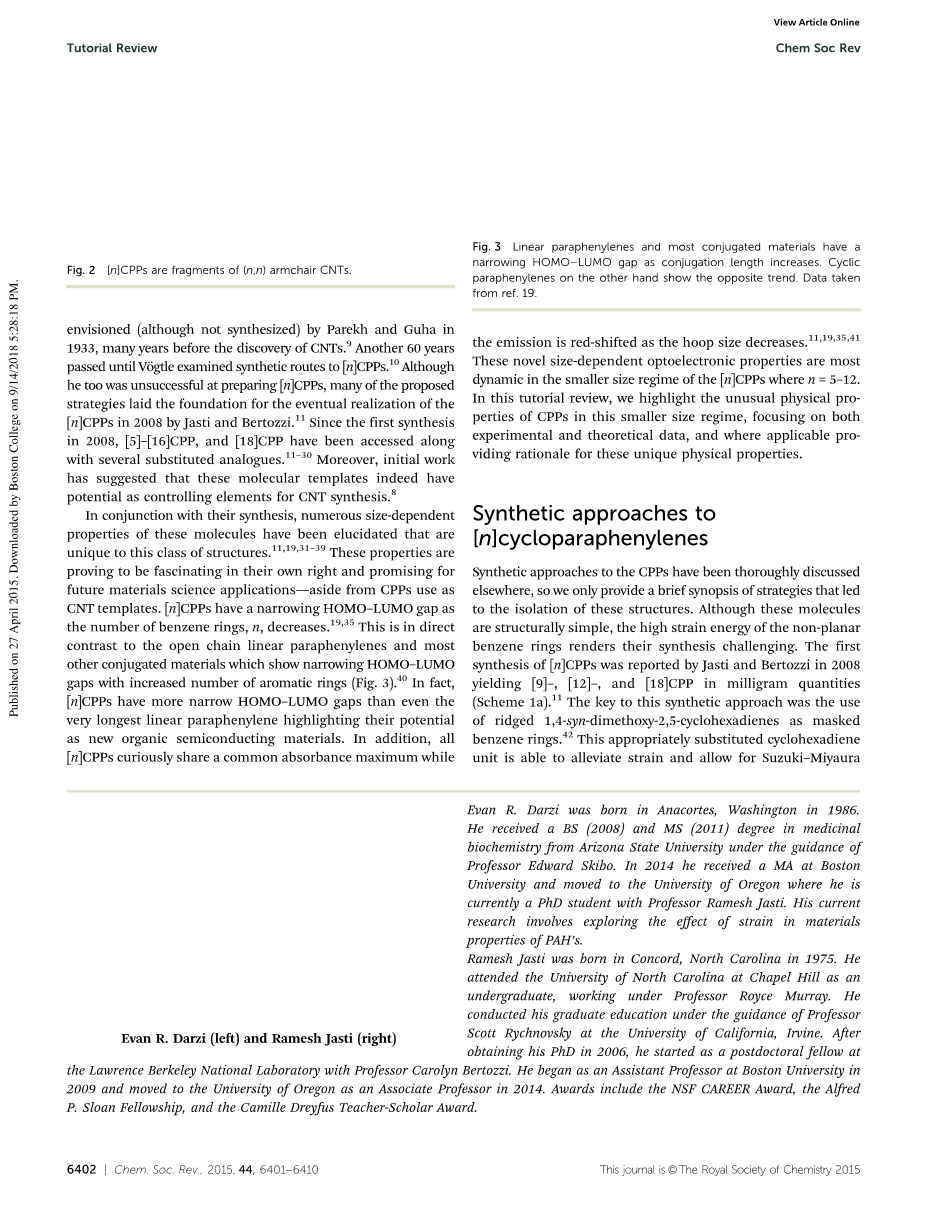

英语原文共 10 页,剩余内容已隐藏,支付完成后下载完整资料
原文
The dynamic, size-dependent properties of [5]–[12]cycloparaphenylenes
Synthetic chemists often pursue structurally unique molecules in anticipation that these unexplored architectures might impart physical properties that are not present in more common motifs. The field of polycyclic aromatic hydrocarbon (PAH) chemistry is rich with examples, commencing with the historic work in the field by Kekule in 1865 when he first elucidated the cyclic six electron aromatic structure of benzene. In more recent years, curved and distorted nonplanar PAHs have attracted significant attention from the scientific community in that these structures push the boundaries of our understanding of aromaticity and electron delocalization. Buckminsterfullerenes and carbon nanotubes (CNTs) have drawn special interest due to their unprecedented material properties and promise in the field of nanotechnology. Pioneers such as Herges with the synthesis of the picotube, Scott with the bottom-up synthesis of C60, and Nakamura with the synthesis of a caged acene belt (Fig. 1) have paved the way for the rational synthesis of new PAHs that continue to push the frontiers of our understanding of these unique structures.
The [n]cycloparaphenylenes ([n]CPPs), which can be envisioned as the shortest cross-section of an [n,n] armchair CNT (Fig. 2), are a fascinating new class of PAHs due to their potential as seeds towards uniform armchair CNT growth. The [n]CPPs were firstenvisioned (although not synthesized) by Parekh and Guha in 1933, many years before the discovery of CNTs. Another 60 years passed until Vogtle examined synthetic routes to [n]CPPs. Although he too was unsuccessful at preparing [n]CPPs, many of the proposed strategies laid the foundation for the eventual realization of the [n]CPPs in 2008 by Jasti and Bertozzi. Since the first synthesis in 2008, [5]–[16]CPP, and [18]CPP have been accessed along with several substituted analogues. Moreover, initial work has suggested that these molecular templates indeed have potential as controlling elements for CNT synthesis.
In conjunction with their synthesis, numerous size-dependent properties of these molecules have been elucidated that are unique to this class of structures.11,19,31–39 These properties are proving to be fascinating in their own right and promising for future materials science applications—aside from CPPs use as CNT templates. [n]CPPs have a narrowing HOMO–LUMO gap as the number of benzene rings, n, decreases. This is in direct contrast to the open chain linear paraphenylenes and most other conjugated materials which show narrowing HOMO–LUMO gaps with increased number of aromatic rings (Fig. 3). In fact, [n]CPPs have more narrow HOMO–LUMO gaps than even the very longest linear paraphenylene highlighting their potential as new organic semiconducting materials. In addition, all [n]CPPs curiously share a common absorbance maximum while the emission is red-shifted as the hoop size decreases. These novel size-dependent optoelectronic properties are most dynamic in the smaller size regime of the [n]CPPs where n = 5–12. In this tutorial review, we highlight the unusual physical properties of CPPs in this smaller size regime, focusing on both experimental and theoretical data, and where applicable providing rationale for these unique physical properties.
Synthetic approaches to[n] cycloparaphenylenes
Synthetic approaches to the CPPs have been thoroughly discussedelsewhere, so we only provide a brief synopsis of strategies that ledto the isolation of these structures. Although these moleculesare structurally simple, the high strain energy of the non-planarbenzene rings renders their synthesis challenging. The firstsynthesis of [n]CPPs was reported by Jasti and Bertozzi in 2008yielding [9]–, [12]–, and [18]CPP in milligram quantities(Scheme 1a).11 The key to this synthetic approach was the useof ridged 1,4-syn-dimethoxy-2,5-cyclohexadienes as maskedbenzene rings.42 This appropriately substituted cyclohexadieneunit is able to alleviate strain and allow for Suzuki–Miyaura cross-coupling/macrocyclization to macrocycles of varying size.In the final reductive aromatization step, these cyclohexadienecontaining macrocycles are treated with lithium naphthalenideat 78 1C to reveal the fully benzenoid hoops. This syntheticstrategy has since been extended and optimized to afford[5]–[12]CPP in a size selective and scalable manner.11,14–18
In 2009, the Itami group introduced a slightly differentapproach to selectively synthesize [12]CPP (Scheme 1b).12 Thisstrategy utilized a substituted 1,4-syn-diarylcyclohexane units asa masked benzene ring to build low strain macrocyclic precursors.10 It is worth noting that these cyclohexane units arereduced versions of benzene rings, where as the Jasti/Bertozzicyclohexadiene approach uses oxidized versions of benzenerings. The low strain cyclohexane containing macrocycle wassubsequently aromatized using p-toluenesulfonic acid at 150 1Cwhich initiates an acid-catalysed dehydrogenation/oxidationevent to reveal [12]CPP. Recent advances to this strategy includenickel mediated intramolecular reductive homocouplings ofaryl bromides, which has led to higher yields and avoids thederivatization of aryl precursors to boronates. This strategy hasbeen used to access [7]–[16]CPP in a size selective manner.12,24–26
Later in 2009, the Yamago laboratory reported the firstsynthesis of [8]cycloparaphenylene using an entirely differentapproach (Scheme 1c).13 This strategy relies on formation of acyclic platinum complex followed by bromine-induced reductiveelimination. Recent advances include the introduction of XeF2 toinduce reductive elimination to prepare even smaller [n]CPPs.21This route has been utilized to access [6]CPP and [8]–[13]CPP inrelatively short synthetic sequences and high yields.13,19–22 Insummary, due to the pioneering work of several groups, a newclass of PAHs that remained dormant
剩余内容已隐藏,支付完成后下载完整资料
资料编号:[236760],资料为PDF文档或Word文档,PDF文档可免费转换为Word
您可能感兴趣的文章
- 通过对奥美拉唑合成反应的监测和定量反应的在线拉曼光谱和表征组件外文翻译资料
- 无金属碳基催化剂的研究进展外文翻译资料
- 钼酸钙/碳三维复合材料可控设计合成的研究外文翻译资料
- 生物催化选择性合成功能化喹唑啉酮衍生物外文翻译资料
- 三元V Zr Al ON氧氮化物-3-甲基吡啶氨氧化的高效催化剂外文翻译资料
- 综述纳米零价铁(nZVI)的合成,特性和在环境修复中的应用外文翻译资料
- 自消毒PVC表面使用点击化学设计外文翻译资料
- 微波辅助直接合成4H-1,2,4-苯并噻二嗪1,1-二氧化物衍生品外文翻译资料
- 微波辅助下直接合成1,1-二氧代-4H-1,2,4-苯并噻二嗪类衍生物外文翻译资料
- 压力选择在变压精馏中的重要性外文翻译资料


